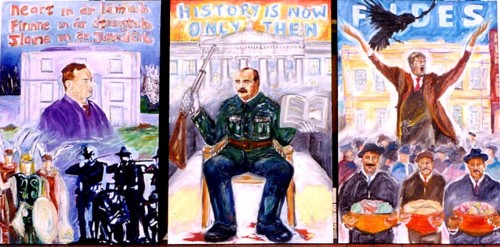|
Caoimhghin
Ó Croidheáin - Notes on work
Pearse, Connolly, Larkin Triptych If Magritte made it clear that all art
consisted of
symbols of people and objects and not the real
world itself then we
must look at all art as
chosen and created by artists for specific aesthetic,
social or political reasons, though they may
not do this consciously.
[A triptych (from the Greek tri- "three" + ptychē "fold") is a
work of art
(usually a panel painting) which is divided into three sections, or
three
carved panels which are hinged together. The central panel is the
most
important one, and this is flanked on either side by two lesser
but related
paintings. The whole is intended to be greater than
the sum of the parts. The
triptych form arises from early Christian
art, and was the standard format for
altar paintings from the Middle
Ages onwards. (wikipedia.org)]
[An icon (from Greek εἰκών, eikon, "image") is an image, picture, or representation; it is a sign or likeness that stands for an object by signifying or representing it. In Eastern Orthodoxy and other icon-painting Christian traditions, the icon is generally a flat panel painting depicting a holy being or object such as Jesus, Mary, saints, angels, or the cross. Though their development was gradual, we can date the full-blown appearance and general ecclesiastical (as opposed to simply popular or local) acceptance of Christian images as venerated and miracle-working objects to the 6th century. (wikipedia.org)] The
Pearse, Connolly, Larkin Triptych contains
many of those forms - three
'saints' (Pearse,
Connolly, Larkin), buildings (The GPO,
Liberty Hall, St Enda's),
a book (Connolly's
writings), text (Pearse's school motto), 'three wise
men' workers
holding baskets of bread fruit
and vegetables and 'disciples' (some of the
boys
of the Celtic plays at St Enda's became
the soldiers of the GPO). James Connolly directs the Rising but is executed
while
seated in a chair because of his
wounds.
The determination to be rid of Connolly was
due as much to his
leadership role as to
the importance of his 'biblical' texts as
a materialist
messiah. Pearse, the cultural
nationalist, and Larkin, the trades' union
organiser, form the other two parts of this
revolutionary 'trinity' showing that
the
compositional forms of the religious
painting or icon can be just as
effective
in the portrayal of an oppositional ideology,
displaying the
indeterminable nature of art.
|


